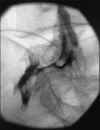A blunt needle (Epimed(®)) does not eliminate the risk of vascular penetration during transforaminal epidural injection
- PMID: 24340239
- PMCID: PMC3841942
- DOI: 10.4103/2152-7806.120784
A blunt needle (Epimed(®)) does not eliminate the risk of vascular penetration during transforaminal epidural injection
Abstract
Background: Transforaminal epidural injection of local anesthetics and corticosteroids is a common practice in patients with radicular pain. However, serious morbidity has also been reported, which can be attributed to an arterial or venous injection of the medication especially particulate glucocorticoid preparations. Using a blunt needle in contrast to sharp needle has been suggested to reduce this risk in a study on animals.
Case description: We present a 59-year-old female with L5 lumbar radicular symptoms and left L5-S1 foraminal narrowing who underwent transforaminal epidural injection with fluoroscopic guidance using a 22-gauge blunt curved needle (Epimed(®), Johnstown, NY). Intravascular needle placement was detected during real-time contrast injection under live fluoroscopy after a negative aspiration and local anesthetic test dose. The needle was slightly withdrawn and correct distribution of the contrast was confirmed along the target nerve root and into the epidural space.
Conclusion: This case report discusses vascular penetration utilizing an Epimed(®) blunt needle to perform transforaminal injections in a clinical setting. This topic was previously discussed in earlier animal studies. We also reemphasize that neither negative aspiration or local anesthetic test doses are reliable techniques to ensure the safety of transforaminal epidural injections.
Keywords: Blunt needle; fluoroscopy; intravascular penetration; radicular pain; transforaminal epidural injection.
Figures
Similar articles
-
Incidence of intravascular penetration in transforaminal cervical epidural steroid injections.Spine (Phila Pa 1976). 2003 Jan 1;28(1):21-5. doi: 10.1097/00007632-200301010-00007. Spine (Phila Pa 1976). 2003. PMID: 12544950
-
Digital subtraction angiography does not reliably prevent paraplegia associated with lumbar transforaminal epidural steroid injection.Pain Physician. 2012 Nov-Dec;15(6):515-23. Pain Physician. 2012. PMID: 23159970
-
Comparison of Intravascular Injection Rate Between Blunt and Sharp Needles During Cervical Transforaminal Epidural Block.Pain Physician. 2019 May;22(3):265-270. Pain Physician. 2019. PMID: 31151334 Clinical Trial.
-
Digital Subtraction Angiography Use During Epidural Steroid Injections Does Not Reliably Distinguish Artery from Vein.Pain Physician. 2016 May;19(4):255-66. Pain Physician. 2016. PMID: 27228513 Review.
-
Fluoroscopically Guided Epidural Injections of the Cervical and Lumbar Spine.Radiographics. 2017 Mar-Apr;37(2):537-561. doi: 10.1148/rg.2017160043. Epub 2016 Dec 9. Radiographics. 2017. PMID: 27935769 Review.
Cited by
-
Iatrogenic Side Effects of Pain Therapies.Cureus. 2023 Sep 2;15(9):e44583. doi: 10.7759/cureus.44583. eCollection 2023 Sep. Cureus. 2023. PMID: 37790027 Free PMC article. Review.
References
-
- Baker R, Dreyfuss P, Mercer S, Bogduk N. Cervical transforaminal injection of corticosteroids into a radicular artery: A possible mechanism for spinal cord injury. Pain. 2003;103:211–5. - PubMed
-
- Bogduk N, Sharp VS. Blunt needles. International Spine Intervention Society White Paper. Interventional Spine. 2005;5:7–13.
-
- Botwin K, Gruber RD, Bouchlas CG, Torres-Ramos FM, Freeman TL, Slaten WK. Complications of fluoroscopically guided transforaminal lumbar epidural injections. Arch Phys Med Rehabil. 2000;81:1045–50. - PubMed
-
- Furman MB, Giovanniello MT, O’Brien EM. Incidence of intravascular penetration in transforaminal cervical epidural steroid injections. Spine. 2003;28:21–5. - PubMed
-
- Heavner JE, Racz GB, Jenigiri B, Lehman T, Day MR. Sharp versus blunt needle: A comparative study of penetration of internal structures and bleeding in dogs. Pain Pract. 2003;3:226–31. - PubMed
LinkOut - more resources
Full Text Sources
Other Literature Sources




